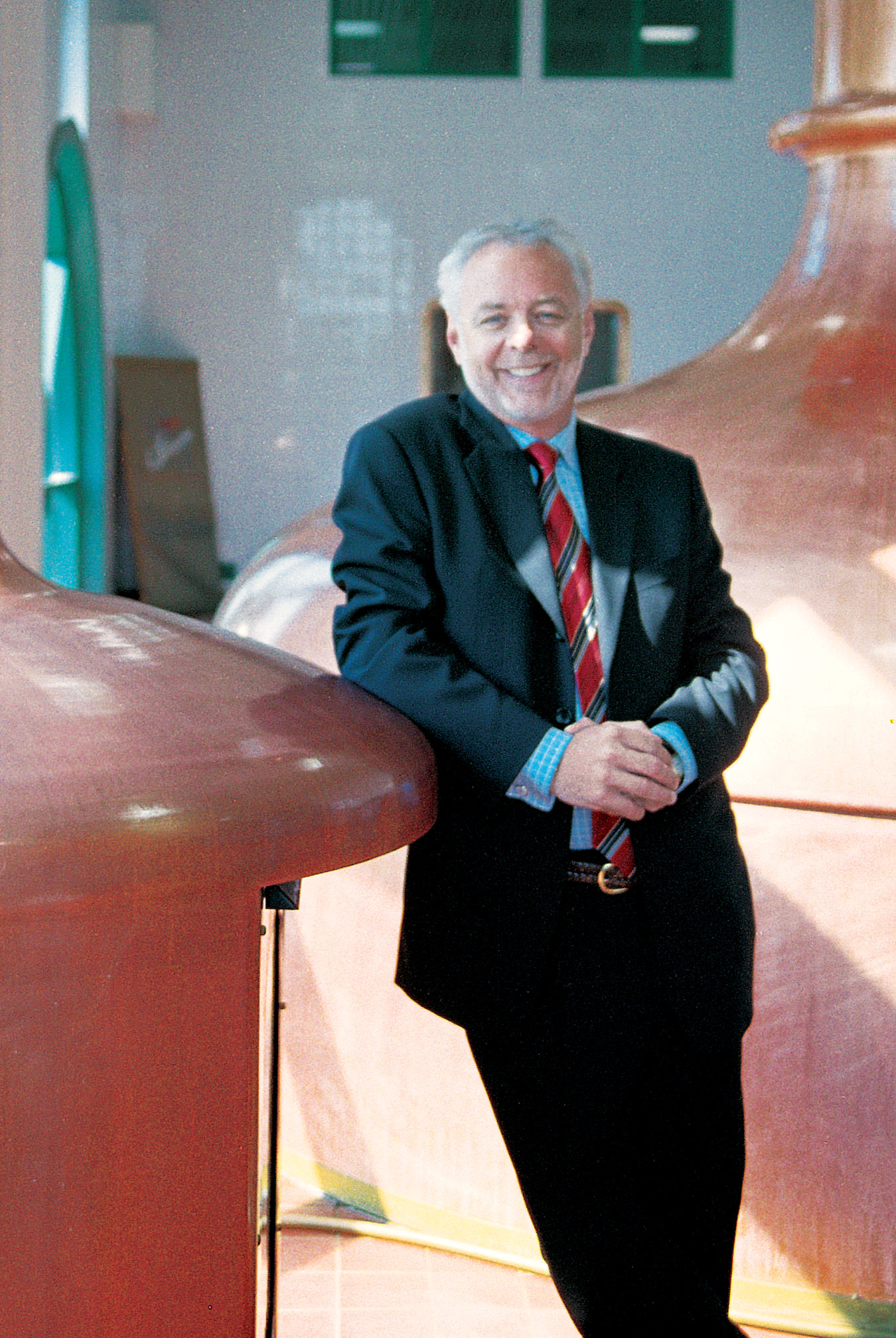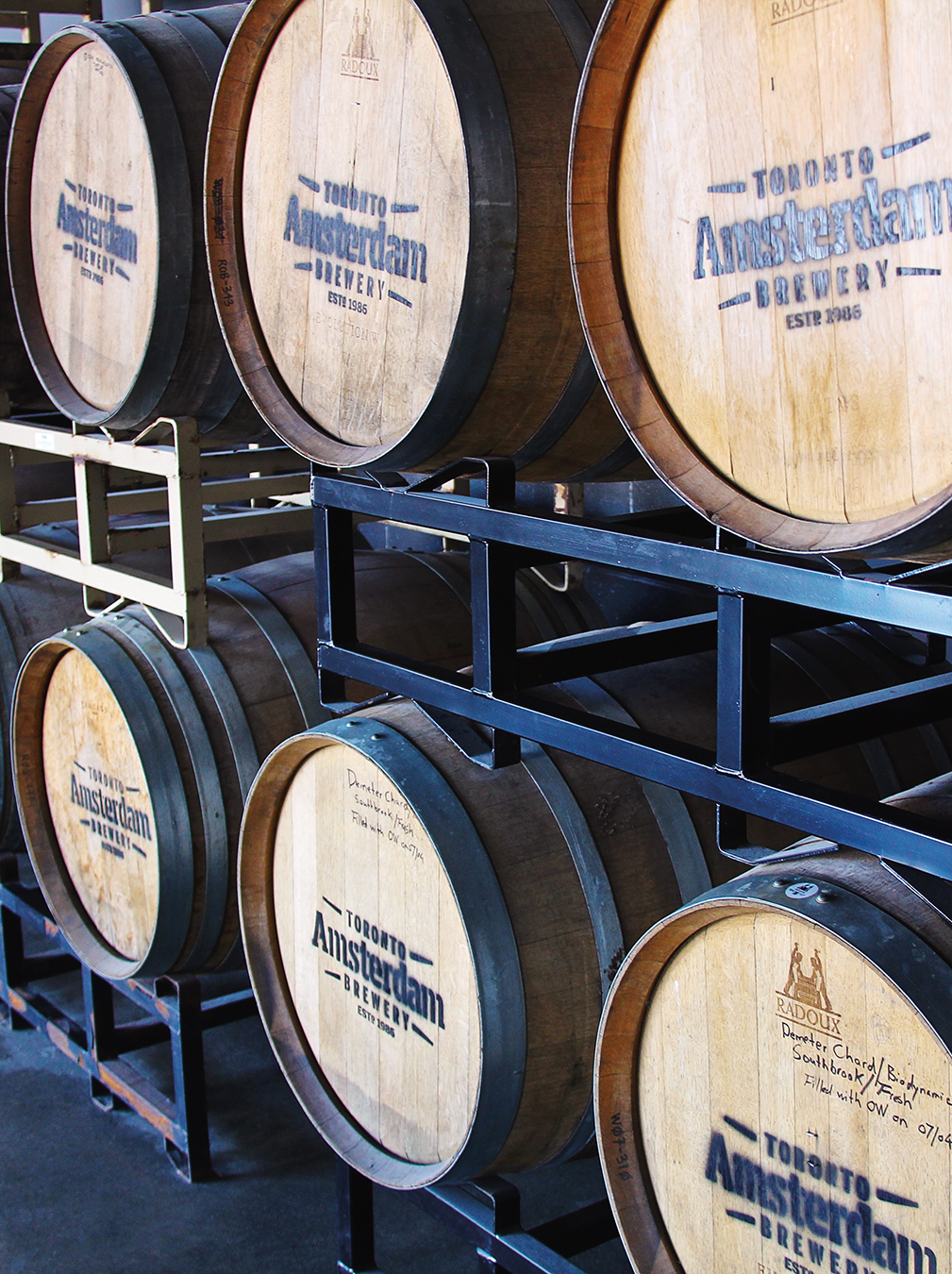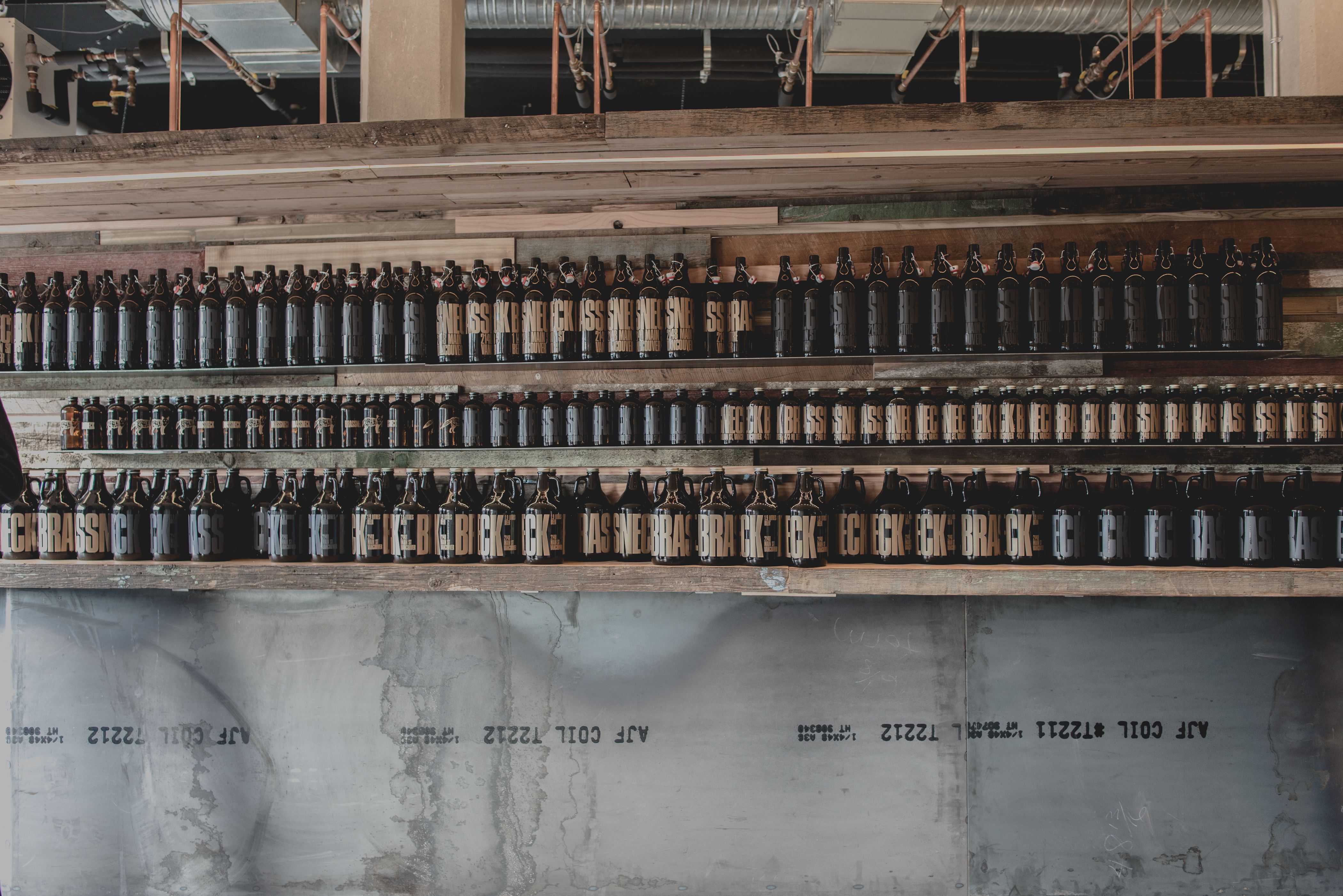John Sleeman
It's not just the head.

The brewery is no longer actually in Guelph, but rather a few kilometres out, not far off the 427 and therefore really not all that far from downtown Toronto. A century and a half ago, where the story begins its Canadian aspect, the brewery was in town, and functioned mainly for German immigrant farm workers, who would dip their pail in a barrel of draft at the end of a working day. What is now Kitchener-Waterloo was then Berlin, Ontario. The massive desk, in the office lined with paintings and pictures of Sleemans past, is a direct link, though, and, as the startlingly familiar voice, known to most only from the distinctive radio ads, kicks into gear, it confirms perhaps the obvious: “Those guys on the walls are my ancestors from England, and we still use English corn in the recipes to this very day.”
John Sleeman, easy in his demeanour and always happy to chat about the brewery he re-built, re-invented, really, continues, pointing to the desk. “It’s my great-grandfather’s and when we were beginning to get this brewery up and running, someone mentioned to me that they knew where the desk was. Sure enough, it could be traced directly,” although, he adds with a smile, “I had to pay a pretty nice sum to get it back.” His approach to business is summed up in this anecdote; the drive to get it right, to pursue the goal, and to give due consideration to the fact that true quality doesn’t usually come cheap.
John Sleeman began in Ontario, but, almost under the radar of the Big Two, Molson’s and Labatt’s, he acquired market share. “We can’t compete with them, going pub to pub and tying the pub up in draft sales. So draft isn’t as big for us. But we wanted to establish a sense of quality, a premium beer that we could charge only nominally more for.” Word got out that Sleeman was a good brew, and the thirsty word travelled well. “Consumers are getting older, a bit more discerning, less volume and more upmarket in their tastes. We fit very well into that. It costs more to make ours, but we don’t want to overcharge.” The Sleeman bottle, clear glass, with the embossed logo of Canadian flag and beaver, has always been mildly criticized in the industry, because beer famously deteriorates with age, and with exposure to light. “Well these things are true, no doubt about that, “ John laughs. But my bottle, exactly like the original 1833 bottle, is a great identifying symbol for us. And we package our beers in totally enclosed cases, so no light gets in.” And then he grins, very broadly: “And when people get the beer, they basically don’t age it or anything, they drink it. So too much age or light really are not factors.” Hard to argue with the inescapable logic of common beer-drinking sense.
That is some of the business side. John’s personal history is the prelude to all this success. “I started a British style pub, but I have to say it looks a lot like hard work, that job. Anyone who romanticizes the life of a pub owner is on the right side of the bar, that’s for sure. But, one day my Aunt Florian took me aside. She basically said “Look John, why do this, when you could think about reviving your family’s old business.” The Sleeman Brewery had operated successfully for nearly a century, until prohibition took hold. (Okay, George Sleeman Jr, was caught smuggling beer into Detroit, and the back taxes levied basically buried the company.) It was never revived, and John himself says, “I didn’t actually know anything about the family history. But Aunt Florian gave me the original recipe book, and I took it from there.” Did he ever. The radio commercials with their famous “I’m John Sleeman. We make good beer” sign-off, told the story of this recipe book, but it is not PR-savvy invention. “I never intended to do the on-air spot myself. But I walked in to the studio, and they started chatting with me, and pretty soon we apparently had a commercial.” John proudly, and a bit tenderly, hands it over for inspection. And there they are, all the original recipes, hand-written in calligraphy the Court stenographer would envy. The house signature Cream Ale, the first thing they brewed and bottled in 1986, sits in this “Record” book, dated January 5, 1898. The fabulous Silver Creek lager is dated “September 20th, 1897”. And so it goes.
Sleeman’s adheres rigorously to the recipe. If it calls for a certain specific kind of malt, they get out the research books and find the most accurate latter-day genetic manifestation of that malt. “I took my mom a 6-pack of Cream Ale when she was in her nursing home. She and the farmhands used to have a beer at the end of the day right there in the field. She recognized the taste immediately.” So being on the right track is gratifying, but not accidental.
Nabisco (Standard Brands) owned the company in its dormancy. “They sold it to me for a buck. They were happy I was going to try and revive the brand.” The brew giant Stroh “helped me build the brewery” and they maintain a solid relationship to this day. There is an efficiency in his business allegiances that creates cost-effectiveness not only at the brewery but also in the distribution lines. “I wake up every morning thinking of ways to grow the company,” John says. And all this thinking has resulted in significant action: the illustrious Unibroue in Quebec, and Okanagan Springs in the West, for example. “We are not interested in changing them, in meddling in a successful product. With Okanagan Springs, for example, I don’t think they would have signed any deal that allowed me to go in and change what they are doing in the brewery. I don’t take pride of ownership in the acquisitions.” The point is to streamline production and distribution, introduce costs of scale. So, now, Okanagan Springs, in Vernon, B.C., continues to tread its established high-quality path, and introduce its own new products. The change is that for certain shifts, they brew Sleeman’s, which is then more cost-efficiently shipped to liquor stores, bars, and other establishments in Western Canada.
The brewery operates round the clock, producing Sleeman products, but also doing contract bottling for Sapporo. The portfolio also includes Upper Canada Brewing Company, Sleeman’s Maritime (formerly the Maritime Beer Company), and Shaftebury. Sleeman’s also represents and distributes Grolsch, Guinness, Pilsner Urquell, Samuel Adams, and Newcastle. Stroh’s continues its affiliation, with Sleeman’s distributing Old Milwaukee, Ranier, and Pabst Blue Ribbon, all “economy” brews, which introduce a whole new dynamic of costs and scale.
Beer has its intricacies in taste profiles, of course. John clearly loves his brew, as a consumer. But, for the technical parts, “I participate in the blind tasting panels, but my palate isn’t what would be necessary for really directing the brew master.” Still, he knows what he likes, and at this stage in his company’s history, he is decidedly not alone in thinking that “I love to sit down with a cold Cream Ale at the end of the day.”
We Make Good Beer
There are many reasons to like John Sleeman, and to really like the company’s products. But, what exactly is the difference between a mass-produced beer of any description and a micro-brew, and a premium beer? Beer is at its quality peak just after brewing, when the foam has just settled on the keg. The very finest I’ve ever tasted, the Caledonian 3.85 Ale, was barrel-brewed, and transferred straight to the pub in that self-same barrel, where it was tapped. Unbelievable freshness, complexity, and remarkably low well under four percent alcohol. But that was Edinburgh, and the logistics even there are rather steep for such a product to make it to market. So for those of us who do not live less than a kilometre from Edinburgh Castle or some other sanctuary of brewdom, a more readily transported article is in order.
Thus technology and science make it possible for a beer to retain the facsimile of freshness for a few months after bottling, with stabilizers, foaming agents, and other intricacies. It is science, since the product is still the lager we all crave on that dusty picnic lunch table. However, the Germans (it is a bit difficult to imagine anyone else doing this) developed a purity law, way back in 1516, called the Rheinheitsgebot. It states pretty succinctly that no beer can call itself ‘pure’ unless it contains, in the most literal sense of it, the four ingredients necessary to make a beer: water, yeast, hops, and malted grain. No additives, full stop.

The rule applies equally to lagers, pilsners, and ales. So, when you do a tour of the relevant shelves in a liquor retailer, this purity law actually does mean something. The beer really will deteriorate with time, will not appreciate the abuse of light and more importantly heat, and will discernibly fade on its flavour palate even in a fridge if left too long. Anyone who has tapped a keg one night, and gone back for a glass the next night, will know how this works: flattened, faded beer.
Sleeman’s point is that most everyone buys it to drink quickly, which, truth be told, is how and why people buy their dinner wines too. Sleeman’s beers don’t put the purity law on their bottles because they follow the original English recipes, and that means they introduce a little corn into the brew. But, Okanagan Springs, for one example among many, rigorously observes the law.
Try a tasting one day. Every region of Canada can boast an increasingly wide array of micro brews. Sometimes, you can only taste at the brewpub that makes it, but for argument’s sake let’s just go to the retail store again, and buy a half dozen to try. You might start with the lighter, hoppier lagers, and work your way through to a bigger, darker ale or two. The key is that there are complexities, nuances. Aroma, colour, acidity and finish all come into play, regardless of personal preferences.
Food accompaniments are not restricted to the entire menu of your favourite Mexican restaurant, either.
What John Sleeman resurrected over two decades ago, as a thorn in the lion’s foot, is now a fundamental part of beer culture in Canada. But what, you might ask, about such luxury products as Heineken, or taste testing champion Pilsner Urquell (you may want to reward yourself one day by visiting the town of Pilsen, where some of this really began, a kind of Bethlehem of beer). Well, it’s all about the recipe, and rigorous quality control. And as in all things, some people do it better than others. The rule of thumb is to follow your palate, since the slightly hoppy ‘skunky’ style of Heineken, mimicked by Tsing Tao and others, is not for everyone. Nor is the effervescent approachability of Corona. But go ahead and put these, too, to the blind taste test. Some will perform amazingly well, even when put up against the strictly purity law conformant beers.
Come to think of it, last time I participated in a blind tasting panel, there were 18 brews, and very big, famous brands did extremely well. The winner, though? Sleeman’s Silver Creek Lager, a full nine points ahead of beer number two.




